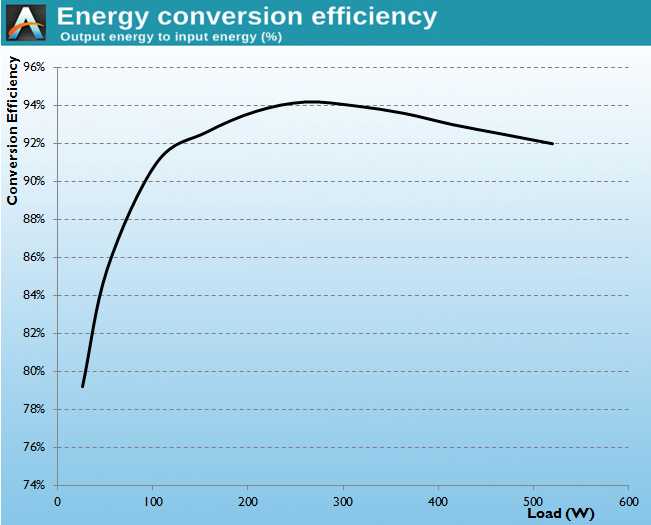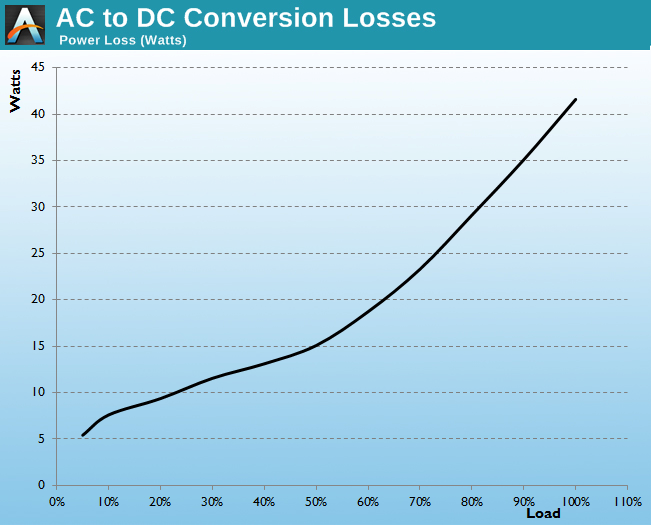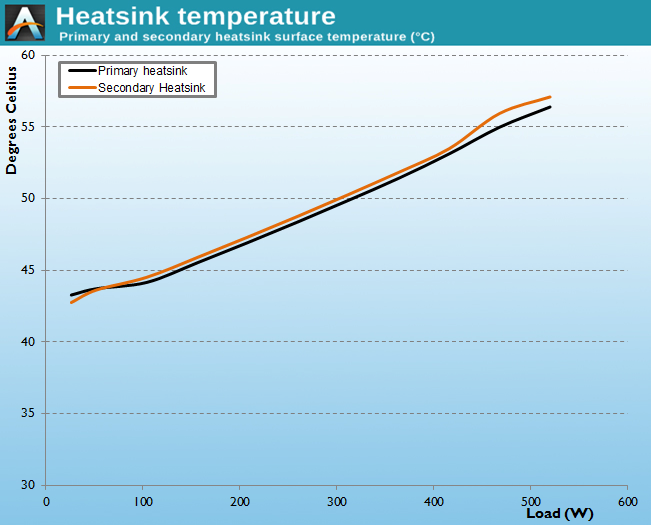SilverStone NightJar NJ520 Power Supply Review
by E. Fylladitakis on July 8, 2014 6:00 AM EST- Posted in
- Cases/Cooling/PSUs
- Seasonic
- PSUs
- Fanless
- SilverStone
Cold Test Results
For the testing of PSUs, we are using high precision electronic loads with a maximum power draw of 2700 Watts, a Rigol DS5042M 40 MHz oscilloscope, an Extech 380803 power analyzer, two high precision UNI-T UT-325 digital thermometers, an Extech HD600 SPL meter, a self-designed hotbox and various other bits and parts. For a thorough explanation of our testing methodology and more details on our equipment, please refer to our How We Test PSUs - 2014 Pipeline post.
Since this power supply is fanless, we are going to have two fewer graphs in this review. The first one is the noise chart, as this product has no moving parts and thus does not generate any noise, and the second one is the air temperature chart, as this method cannot be accurately applied if there is no forced airflow.
The electrical performance of the Nightjar NJ520 is excellent, which was to be expected from a Seasonic design. At room temperature, the Nightjar NJ520 easily meets the 80Plus Platinum certification and displays an average energy conversion efficiency within the nominal load range (20% to 100%) of 93.0%. Loads lower than 50 Watts however have a significant impact on the efficiency, which drops below 80%. This does not affect the 80Plus certification, which takes into account only the 20% to 100% nominal capacity range.
Even though it is a very efficient model, the Nightjar NJ520 remains surprisingly cool for a passive power supply, with the temperature of the primary and secondary heatsinks reaching up to 56.4 °C and 57.0 °C respectively. Although these figures are relatively high for a 520 Watt model in room temperature, the Nightjar has no forced cooling and therefore it is perfectly natural for it to be warmer than typical units.













44 Comments
View All Comments
houkoholic - Wednesday, July 9, 2014 - link
The usual good silent case with the right padding are also big. My last two silent cases were the famed Antec P180/182. Sure they were silent but they were nearly full tower size huge, I simply have no need for so much space in my current lifestyle when all I need in my build that isn't already on the motherboard is nothing more than a SSD, a single data storage HDD and one GPU.Recently I build a small micro-ITX build using the Antec ISK600 case, the shell of that case is just thin aluminium with no sound proofing unlike the P180s. So I put in a fanless PSU in there, threw out the Intel cooler for a Noctua tower cooler which runs a 120mm fan, the included case fan was good enough to be near silent thus my only component which makes any sort of whirling noise now is the the GPU stock cooler. In the end my build is silent and its footprint is small enough that I can put it on a bookshelf right next to my ears yet it is powerful enough for gaming. My total fan count in the build is 3 instead of 4, and one less fan is still one less component to worry about contributing to noise.
houkoholic - Wednesday, July 9, 2014 - link
One less part contributing to the noise can still factor in. Any fan could be victum to dust and wear which causes it to start making noise (happened to me a few times with PSU). If I have to pay for the privelage such that I don't have to clean my PSU fan as well, so be it, and that already has a point for its existence - and I suspect that there are enough people out there thinking the same to justify the existence of such products.dishayu - Wednesday, July 9, 2014 - link
This will go really well with my reference design R9 290. :Dsheh - Wednesday, July 9, 2014 - link
Thanks for the review!A request: Can you start testing PSUs at specific load (or draw) wattages instead of percentages, and go lower than 50W? Percentages arne't very meaningful by themselves, and watts can be compared directly. And watt-wise, modern computers under light load take less than 50W. Much less, actually. So 20% of this PSU might be what a modern computer draws at maximum CPU load.
mapesdhs - Wednesday, July 9, 2014 - link
I agree, I think my gateway uses about 30W or so.
Ian.
E.Fyll - Wednesday, July 9, 2014 - link
Actually no, because that is beyond the testing guidelines. 20% is the minimum acceptable testing limit for switching PSU power quality tests. It would also be meaningless to test a 1000 Watt unit at 50 Watt; that only implies that this unit should not have been there in the first place.Switching PSUs are inherently not capable of efficient operation at very low loads. It is worse to have a far too powerful PSU rather than a heavily loaded PSU.
torp - Thursday, July 10, 2014 - link
Testing guidelines be damned. A modern desktop idles at 40 W or less. I don't care what the specifications say, I want to know the efficiency in real world conditions. It's not like you can buy sub 500 W PSUs any more... with the lone exception of Seasonic's G360... if still available.sheh - Thursday, July 10, 2014 - link
400-450W are rather common, and maybe some <400W as well. But I think what's more pertinent is that span of loads in modern computers is larger than it used to be. CPUs and graphics cards have better dynamic power management and are more efficient in general, but you also have graphics cards with extreme power draws under load, and sometimes multiple cards in one system.sheh - Thursday, July 10, 2014 - link
Isn't the 20% thing just an old decision by Ecos Consulting? I guess even a modern tri-SLI system will use <100W on light desktop load.versesuvius - Thursday, July 10, 2014 - link
Underclocking is the word. It is also a good idea. A true enthusiast's wonderful scheme. Want a stable, reliable, quite system? Pay as much as is possible and then underclock, cpu, gpu, ram. For power supply this model has done it for you already out of the box. Better yet, buy a 1600 watt unit, which almost always uses no fan above 600 watts and you are even better set.